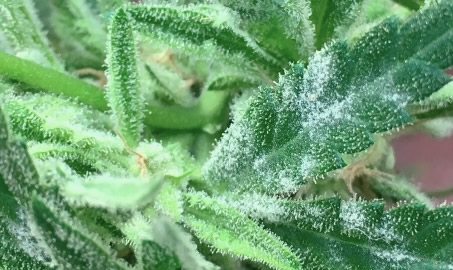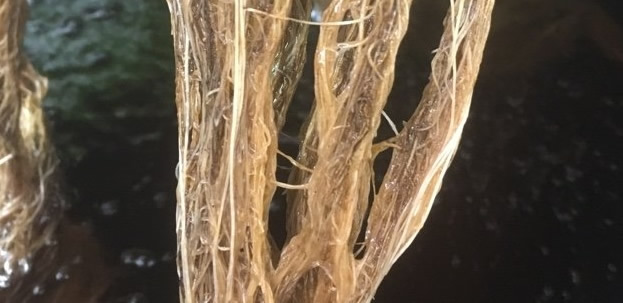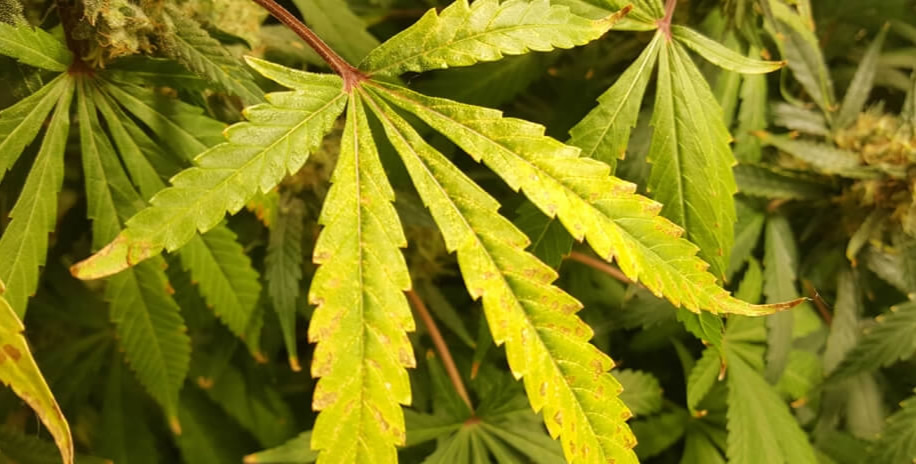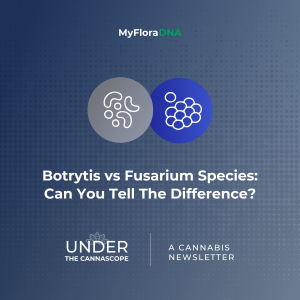Emerging Cannabis Dieseases in California
Emerging Cannabis Dieseases in California
The most critical diseases and viroids of cannabis in California include hop latent viroid, root and crown rots, powdery mildew, bud rots, and post-harvest flower molds. This article aims to help cannabis growers improve their understanding of these diseases and adopt appropriate management practices to limit the introduction, establishment, and spread of the pathogens and reduce the damage they cause to cannabis production in California.
The most significant challenge cannabis and hemp producers face is the management of insect pests and pathogens that attack the roots, leaves, and inflorescences.
Using symptomatology and morphological criteria is not enough, and molecular approaches for pathogen identification are currently the most comprehensive way available.
Powdery Mildew

Description and Distribution
Powdery mildew is caused by Golovinomyces species, including G. cichoracearum, G. ambrosiae, or G. spadiceus. These pathogens are present in B.C., eastern Canada, the USA, and likely elsewhere. The host range of the pathogens may include other, yet undetermined, plant species. In outdoor-grown cannabis and hemp, a powdery mildew infection may also be caused by Podosphaera macularis, the causal agent of powdery mildew on hops. Infection by the pathogen from hops to cannabis and hemp has been reported in New York but is very infrequent.
Symptoms
Powdery mildew may affect plants at all stages of growth, and the symptoms appear on leaves, flowers, and occasionally on stems. The pathogen’s mycelium and conidiophores (i.e., spore-producing structures) appear as distinct white powdery patches on the upper surface of leaves, flowers, and occasionally stems. Masses of spores are produced and released when plants are disturbed. Powdery mildew infections may cause leaves to turn brown and drop prematurely. Diseased plants may also have stunted growth with poor-quality flowers. The effects on overall yield are not known. Powdery mildew infections are localized to the infected tissues. Systemic infections and the internal spread of the pathogen have not been demonstrated.
Transmission
Spores of Golovinomyces spp. spread primarily through the air, although contaminated clothing, equipment, and tools may also spread the pathogen to a lesser extent. The pathogen may be introduced into a growing facility on infected plants, including cuttings or mother plants. The severity and incidence of powdery mildew infection are enhanced by rapid temperature and humidity fluctuations, high humidity, and inadequate air movement. Cannabis strains may differ in their susceptibility to powdery mildew, with some showing apparent resistance to the disease. Therefore, selecting cannabis strains that are resistant to powdery mildew is essential.
Pythium Crown and Root Rot

Description and Distribution
Several species of Pythium, including P. myriotylum, P. dissotocum, P. aphanidermatum, and P. ultimum, have been reported to infect cannabis in B.C. and other parts of North America. These pathogens, also known as water molds, affect many greenhouse crops, including pepper, tomato, cucumber, ornamentals, and several other field crops such as strawberries. Therefore, the host range of the Pythium species infecting cannabis is broad, and the pathogens may originate from and spread to other host plants.
Symptoms
Pythium causes roots to appear brown, rotten, and a distinct lack of feeder roots. The outer region of infected roots may easily slough off, leaving only the vascular tissue intact. Symptoms of crown rot appear as dark, sunken lesions at the base of plants, extending several centimeters up on the stems. Infected plants often show signs of stunting, and leaves may later turn yellow. Wilting occurs rapidly under warm and sunny conditions. Diseased plants may emit an odor due to secondary invasion by bacteria, especially during warm weather.
Transmission
Pythium produces mycelium, water-borne spores (zoospores), and long-lived oospores on diseased plants and in growing media. These can subsequently be spread by water, contaminated growing media, insects, and plant debris. Contaminated tools and equipment, including irrigation systems, may also spread Pythium. Root damage and overwatering can contribute to Pythium infection. The pathogen can grow at temperatures of 10-35°C, although it thrives around 30°C.
Bud Rot
Description and Distribution
Botrytis cinerea, also known as “grey mold,” is the primary cause of bud rot in B.C. and other Canada and the USA regions. The pathogen can also cause stem canker on cannabis. The range of plant species that can be affected by Botrytis is extensive and includes over 500 species.
Symptoms
Buds (inflorescences) affected by Botrytis initially appear soft and discolored. As symptoms progress, buds may turn crisp and brown. Infections commonly start in the interior of the buds, where humidity is highest, air movement is lowest, and progress outwards (Fig. 4B). Grey or off-white mycelial growth may also be observed on affected buds. Under high humidity, the pathogen will sporulate and produce a characteristic grey mold. Stem cankers appear as slightly sunken tan or off-white areas on the main stem or at branching points where an injury has occurred. Grey sporulation is also often observed on the cankers. Most infections occur during the early fall and winter seasons and rarely during the warm summer months. The pathogen does not grow at temperatures over 30°C but can grow at 5-10°C.
Transmission
Botrytis spreads primarily as spores through the air. Spread may also occur from infected plant debris, tools, equipment, and on the clothing of staff and visitors. Adjacent crops susceptible to grey mold may be a source of spores, while damaged plant tissue is more susceptible to infection. The disease thrives in high relative humidity environments with poor air circulation and moisture condensation on plant surfaces. Plants receiving excessive levels of nitrogen may also be predisposed to Botrytis infection. The risk of infection of inflorescences resulting in bud rot is greater as buds reach maturity. Cannabis strains with large inflorescences with many closely packed flowers are more susceptible to infection than loosely arranged flowers.
Virus and Viroid Diseases

Description and Distribution
Confirmed reports of viruses affecting cannabis plants remain low. However, samples recently diagnosed using molecular approaches confirm that Tobacco mosaic virus, Cucumber mosaic virus, and Alfalfa mosaic virus are present in cannabis plants in California. These viruses also have wide host ranges and affect other commonly grown crops such as tomato, cucumber, and other vegetables. Hop Latent Viroid (HpLVd) has been reported to infect cannabis in California, other areas of the USA, and Canada. HLV also infects hops and is distributed in hop-growing regions worldwide, where it causes no symptoms (i.e., they remain latent).
Emerging Cannabis Dieseases in California
Symptoms
Actual virus symptoms include alternating patterns of yellow and green (mosaic), yellowing on certain parts of the plant, or curling, distortion, and narrowing of young leaves. In addition, line patterns may be produced on diseased leaves. The effects of viruses on cannabis yield and flower quality have not been determined. Symptoms of HLVd include stretched and horizontal plant growth, brittle stems, malformed or chlorotic leaves, and stunting. Plants may also “dud” when flowered, with flowers appearing small and malformed. The production of secondary metabolites, such as cannabinoids and yield, is also negatively affected. Plants may remain asymptomatic but still harbor HLVd or viruses.
Virus disease symptoms may be easily confused with nutrient deficiencies, such as iron, magnesium, or nitrogen, that cause yellowing or striping of leaves. In addition, other abiotic stresses causing distortion or curling of leaves may appear similar to virus disease. Due to poor environmental conditions, stunted growth may resemble a virus infection, especially if accompanied by foliar symptoms. Herbicide injury can resemble the symptoms of virus infection.
Transmission
These viruses and viroids may be brought into the growing environment via infected mother plants, cuttings, and potentially seeds. HLVd and viruses can spread using contaminated tools, equipment, and on the hands and clothing of staff, especially during pruning and handling of plants.
Other emerging pathogens
Below is a list of other potentially essential pathogens observed on cannabis in California that producers should be aware of: Alternaria stem canker, bud rot Sclerotinia stem canker, bud rot Stem cankers caused by Diaporthe, Neofusiccocum and Lasiodiplodia spp.
Control Measures for Cannabis Diseases
In general, maintaining clean and sanitary conditions in cannabis growing facilities can reduce the incidence of many diseases. You can minimize the potential spread of pathogens by using footbaths at the entrances to the cannabis growing areas and using hairnets, beard nets, and gloves for visitors and staff.
Air filtration and purification systems such as HEPA filters and UV may also be used to reduce airborne contaminants and pathogens. Maintain appropriate humidity and air-temperature levels and improve air circulation in cannabis production and post-harvest processing (drying) areas to prevent or minimize powdery mildew, Botrytis bud rot, and post-harvest decay.
Minimize damage to buds during harvest and trimming to reduce post-harvest bud decay. Treat irrigation water with UV, chlorine, or other registered products to prevent the spread of pathogens responsible for root rot, crown rot, and damping-off. Scout for and remove diseased plants and tissues from growing cannabis or post-harvest processing areas to minimize inoculum buildup and disease spread.
Use disease-free planting stock or cuttings from healthy mother plants for propagation. Producers should ensure that new plant materials entering the growing facility, such as cuttings or planting stock, are quarantined and inspected for disease symptoms or the presence of insect pests.
Conclusion
Over the past four years, many fungal, viral, bacterial, and nematode pathogens have been reported to cause diseases on cannabis and hemp crops in North America.
This article has attempted to summarize these diseases and discuss mitigation approaches utilizing several strategies. Implementing certified pathogen-free planting material is an essential first step, followed by the utility of biological control agents, which still require research to determine their comparative efficacies and modes of action.
The surge in cannabis and hemp cultivation is providing many opportunities for collaboration between growers and Testing laboratories to solve emerging disease problems and ensure that consumer safety always remains a top priority.
“Know your enemy” is vital to control diseases early. MyfloraDNA laboratory offers a variety of testing services including, Pathogen detection services, Genetic testing, and whole-genome sequencing services.
As soon as we receive samples for testing, we guarantee a rapid turnaround time with results from our lab straight to the grower’s hands. Selecting the plant stock is very important to grow disease-free plants. Our main goal is to help you to grow healthy and secure cannabis, improve your production and preserve the quality of your main cannabis strains.
Contact us!



